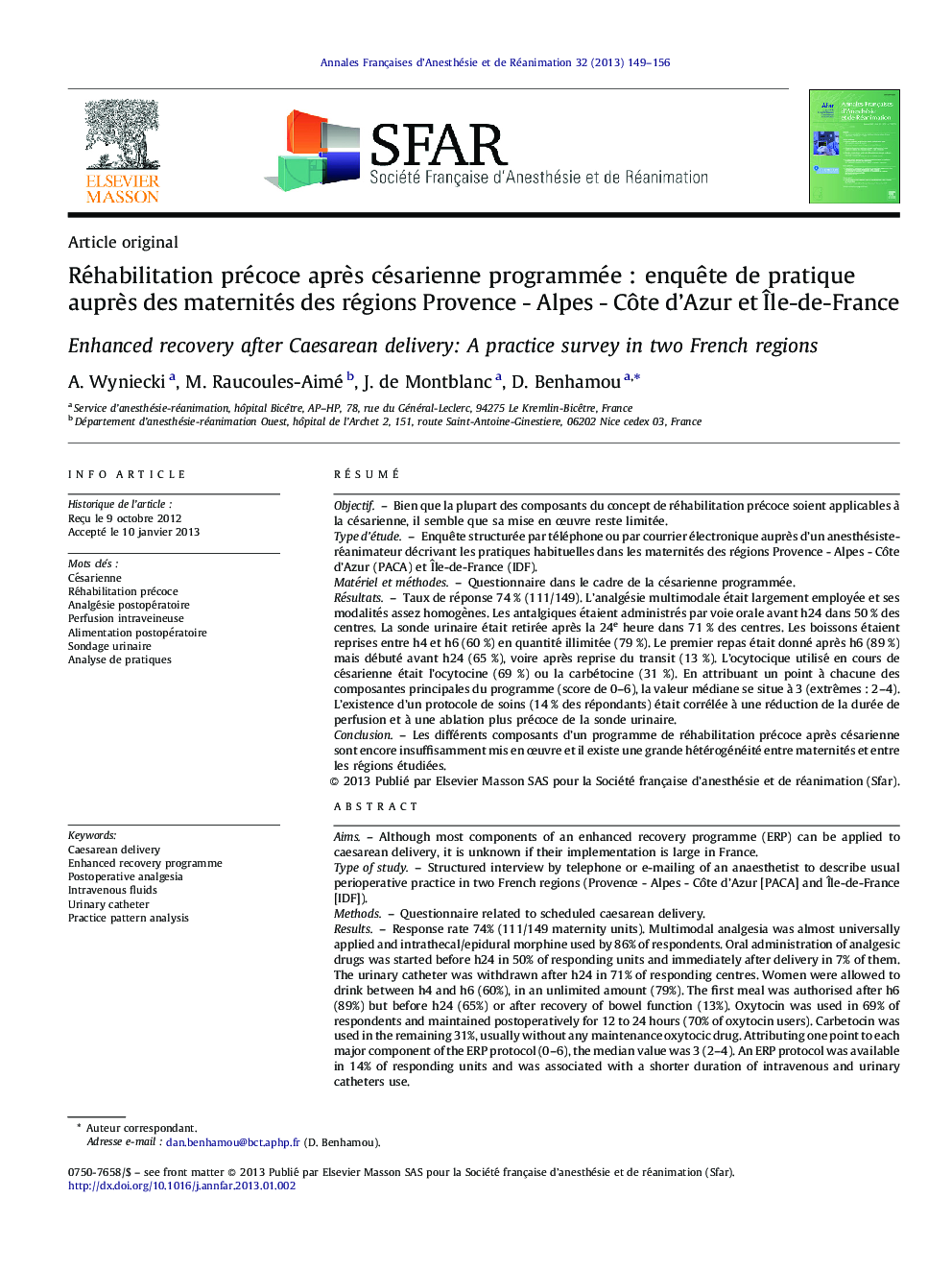| Article ID | Journal | Published Year | Pages | File Type |
|---|---|---|---|---|
| 2745729 | Annales Françaises d'Anesthésie et de Réanimation | 2013 | 8 Pages |
RésuméObjectifBien que la plupart des composants du concept de réhabilitation précoce soient applicables à la césarienne, il semble que sa mise en œuvre reste limitée.Type d’étudeEnquête structurée par téléphone ou par courrier électronique auprès d’un anesthésiste-réanimateur décrivant les pratiques habituelles dans les maternités des régions Provence - Alpes - Côte d’Azur (PACA) et Île-de-France (IDF).Matériel et méthodesQuestionnaire dans le cadre de la césarienne programmée.RésultatsTaux de réponse 74 % (111/149). L’analgésie multimodale était largement employée et ses modalités assez homogènes. Les antalgiques étaient administrés par voie orale avant h24 dans 50 % des centres. La sonde urinaire était retirée après la 24e heure dans 71 % des centres. Les boissons étaient reprises entre h4 et h6 (60 %) en quantité illimitée (79 %). Le premier repas était donné après h6 (89 %) mais débuté avant h24 (65 %), voire après reprise du transit (13 %). L’ocytocique utilisé en cours de césarienne était l’ocytocine (69 %) ou la carbétocine (31 %). En attribuant un point à chacune des composantes principales du programme (score de 0–6), la valeur médiane se situe à 3 (extrêmes : 2–4). L’existence d’un protocole de soins (14 % des répondants) était corrélée à une réduction de la durée de perfusion et à une ablation plus précoce de la sonde urinaire.ConclusionLes différents composants d’un programme de réhabilitation précoce après césarienne sont encore insuffisamment mis en œuvre et il existe une grande hétérogénéité entre maternités et entre les régions étudiées.
AimsAlthough most components of an enhanced recovery programme (ERP) can be applied to caesarean delivery, it is unknown if their implementation is large in France.Type of studyStructured interview by telephone or e-mailing of an anaesthetist to describe usual perioperative practice in two French regions (Provence - Alpes - Côte d’Azur [PACA] and Île-de-France [IDF]).MethodsQuestionnaire related to scheduled caesarean delivery.ResultsResponse rate 74% (111/149 maternity units). Multimodal analgesia was almost universally applied and intrathecal/epidural morphine used by 86% of respondents. Oral administration of analgesic drugs was started before h24 in 50% of responding units and immediately after delivery in 7% of them. The urinary catheter was withdrawn after h24 in 71% of responding centres. Women were allowed to drink between h4 and h6 (60%), in an unlimited amount (79%). The first meal was authorised after h6 (89%) but before h24 (65%) or after recovery of bowel function (13%). Oxytocin was used in 69% of respondents and maintained postoperatively for 12 to 24 hours (70% of oxytocin users). Carbetocin was used in the remaining 31%, usually without any maintenance oxytocic drug. Attributing one point to each major component of the ERP protocol (0–6), the median value was 3 (2–4). An ERP protocol was available in 14% of responding units and was associated with a shorter duration of intravenous and urinary catheters use.ConclusionThe study shows that the components of an ERP are insufficiently implemented in France after caesarean delivery. Moreover, significant heterogeneity exists between maternity units and among regions.
